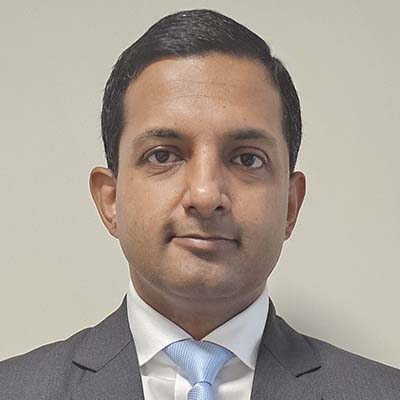

- Connie Lyu
- Treasury Advisory Executive, APAC, Global Transaction Services, Bank of America

- Geetika Vats
- Head of Corporate Sales, India, Global Transaction Services, Bank of America

- Narendra Kumar Parhi
- Head of Digital Channels APAC and Head of Treasury Products Hong Kong, Global Transaction Services, Bank of America
Delivering On-Time Treasury Value to All
In an era of instant data, treasurers can no longer afford to work with out-of-date information or deliver vital numbers to their business leaders ‘as soon as possible’. Instead, they want information on demand and on time.
Here, three subject-matter experts from Bank of America unpack the drivers, approaches, opportunities, and possible outcomes of becoming the ‘on-time’ function that truly opens the door of treasury-as-a-business (TaaB) to all.
In today’s commercial environment, making the right decisions quickly is an imperative. Yet many organisations are still clinging on to workflows that use batch processing and end-of-day cash and liquidity reporting. This can hinder the ability to tackle new and evolving risks before they’ve become a serious threat. For treasurers, making the C-suite wait for the right data could mark the difference between success and failure. But even if the right data is on tap, it still has to be managed and presented as a clear and usable resource for it to be of any value. This is where the idea of on- time treasury, discussed in the two previous articles in this series really starts to make sense as it pulls treasury into the everyday reality of TaaB.
One size does not fit all
It is important to acknowledge that real-time, on-time periodically, and batch processing serve different needs, and that there is no one-size-fits-all solution that treasury should adopt, notes Connie Lyu, Treasury Advisory Executive, APAC, Global Transaction Services, Bank of America.
Every process must reflect business needs. Once a corporate treasurer herself, Lyu cautions that systemic changes will not happen overnight. “In many cases it will be an industry effort; change cannot be managed by treasury alone. The end-to-end process has to be reviewed and redesigned where necessary, the infrastructure has to be in place to support these new frameworks, and the stakeholders contributing to that effort include the banks and FIs, and the domestic and regional authorities where FX and cross border transactions are involved.”
Of course, this effort is underway, with many systems having evolved towards real-time payments (RTP) over the last decade. Geetika Vats, Head of Corporate Sales, India, Global Transaction Services, Bank of America says that those businesses persisting with their old-school approaches are yet to experience the empowerment that comes with a dynamic view of their accounts or balance sheets. “The old platforms do not give treasury the visibility they need today; they simply cannot know what payments are coming into their accounts. Without that view, the efficient use of cash across the business becomes an issue, especially where treasury is called upon to support growth initiatives or instil resilience.”
With the notion of TaaB in mind, Narendra Parhi, Head of Digital Channels APAC and Head of Treasury Products Hong Kong, Global Transaction Services, Bank of America, explains that the required view has to be holistic, with essential consideration given to real business use cases in the commercial context. For many companies operating globally, he feels batch processing is a challenging proposition at best. “If a business seeks to work as a holistic global entity, it has to have up to date information availability across all time zones in which it operates. This is where batch processing, and the standard working week, no longer suit that context.”
Indeed, this is also where an enhanced capacity to tackle risk and leverage opportunity creates a compelling pull towards an on-time set-up for a business and its treasury function, says Lyu. Being able to rapidly identify changes in patterns within on-time data enables a business to be more sensitive to market nuances, responding quickly to market price changes, client payment behaviours, and supply chain challenges. This is very much the strength of on-time systems. By leveraging AI and machine learning technologies, on-time data can not only give information on actual events but also efficiently assess future outcomes under different what-if scenarios.
And with new technologies in development and distribution via the bank, fintech and vendor communities, user expectations – especially in the B2C space – are growing. As a result, Lyu believes treasuries are feeling increased pressure from business teams to adapt to the new “always- on and always-changing” environment.
That pressure, she notes, has seen corporate treasurers actively seeking information from different sources – including banking, regulatory authorities, and policy setters – “so that whether they leverage new technologies or not, they are well prepared and never miss an opportunity”.
According to Vats, there is an “opportunity ecosystem” to leverage, with operational efficiency and quick decision-making possible only where there is access to real-time or on-time information. For example, on-time information of collections can help manage customer credit lines, and facilitate the dispatch of goods through a just-in-time model.
The adoption of on-time treasury, and the visibility that it offers, enables firms to “meet a need as and when required”, says Lyu. “A deep knowledge of the business that stems from enhanced data analysis means treasury is able to provide a set of options with optimised recommendations for business decision-making.”
By giving treasury greater control over financial data, Vats believes on-time delivery places the function at the centre of the risk management structure. This, in turn, boosts its capabilities around the management of fraud – giving it an appropriate framework within which to operate, while disseminating information and guidance to the rest of the business.
Parhi, too, believes there is an opportunity for treasury not only to supplement corporate data “as and when needed” but also to become a critical strategic function within the business. With access to insight derived from multiple data inputs, on-time data places treasury in a strong position, for example, to help set long-term strategy. “It presents a great opportunity for treasury to leverage data and associated analytics to be at the forefront of everything TaaB brings to the wider organisation.”
New building blocks
Building the on-time structure that facilitates the rise of TaaB starts with a full treasury understanding of the business and its processes. From here, process design and automation can begin to build the strong footing of standardised and comparable data.
This phase should therefore incorporate end-to-end mapping of the cash conversion cycle. The data that flows within this process must be screened for both quality and usefulness – in a treasury and wider business context. This is important because output from its analysis will help guide real-world commercial decisions and actions, based on a range of actual and what-if scenarios.
To bring such a scenario to life, Lyu says access to the right data enables treasury to advise the business before a major commercial contract is signed. “Having that broad view across the business means, for instance, that treasury can present cash flow forecasts based on the terms and conditions of that contract, ascertaining positive cash flow across the entire project life cycle. It also facilitates warnings when and how much negative flows will be if the business is willing to take the risk.”
What’s more, says Lyu, in the transformation to an on-time structure, which can be challenging due to resistance to change, “strong relationships and collaboration between treasury and the wider finance department, and IT and legal departments are essential”.
Technology also has an important role to play in this undertaking. An honest appraisal should assess the essential technical components of the proposed on-time structure, versus the optional, notes Lyu.
Part of that discussion should explore the most effective core technology – Treasury Management System (TMS) or Enterprise Resource Planning (ERP) – to deliver the planned on-time structure, notes Vats. “Automation from front to back office is vital not only if an organisation is to benefit from sophisticated risk management or reconciliations tools, for example, but also if on-time data is to be accessible by all departments.”
A further consideration for those evaluating an on-time structure is their current level of treasury centralisation, continues Vats. “We have clients working with regional hubs or shared services centres and payments factory models, and these are a major advantage when moving towards on- time,” she comments.
Parhi additionally highlights the level of reach across all bank accounts and transactions globally as a factor for success. However, he says there should also be a strong focus on control over that environment. “Once there is visibility, the business needs to ensure that it has sufficient control over its balances. When control is diminished, treasury needs to find a way of bringing it back under control, to deploy it when
A third focal point Parhi proposes is the need for a TaaB function to optimise returns on its balances. Here, he believes treasury should be looking, based on its risk appetite, to leverage the on-time structure to automate opportunities for yield across markets and instruments, especially in the current rising rate environment.
Achieving all of these elements demands a suitable technological infrastructure together with a standardised and scalable data format and practice, Parhi continues. ISO 20022 XML, for example, is the kind of “universal future- proof format” that is fundamental to the creation of a globally resilient and consistent on-time technology infrastructure in the long term.
TaaB will change treasury
The ability of treasury to become a genuine TaaB operation depends in the first instance on how much it knows and understands the business and market in which it operates, comments Lyu. However, creating a structure capable of offering the level of visibility and process continuity afforded by an on-time and scalable data setup is the next step in the journey to TaaB.
That structure puts treasury on a strong footing when it comes to explaining a business plan to an investor or auditor or offering accurate financial reporting to the authorities. Internally, it can bring treasury closer to teams such as sales, procurement, legal, or commercial, ensuring that on-demand data and analysis are accessible by all.
Meanwhile, for Parhi, the power of the TaaB concept “is that it enables treasury to participate across the entire spectrum of decision-making of the company, making that business more robust and sustainable. With stronger connections, treasury’s core function can now extend out to the longer-term strategic business decisions and goals.”
Partner power
“At Bank of America, we are committed to supporting the TaaB model and updating clients on what is really happening in the industry,” says Vats. “This means making sure they are fully aware of the technological evolution within payments systems, as well as offering insights into the adoption of best practices around the application of cash, reconciliation or the digitalisation of cross-border transactions.”
A global bank such as Bank of America is able to bring a high degree of standardisation and flexibility to the table, comments Parhi. “As a single provider, across all geographies, we have a consistent product, service, and technology offering complementing the consistency of the infrastructure required by clients to become effective TaaB operations. Our advisory approach leverages local expertise to customise the solution for each use case. It’s all about delivering global standardisation with the flexibility of local customisation.”
The successful fusion of standardisation and flexibility, including a globally consistent CashPro® and liquidity infrastructure – which combines robust standards like ISO 20022 XML, full digital capabilities and customisations and connectivity to local clearing networks – is what drives the bank’s TaaB approach. With today’s businesses needing to make the right decisions quickly, the agility of the TaaB operation perfectly places the treasurer to become an indispensable ‘on-time’ enterprise information broker, and with it, a partner for growth and resilience.
According to Lyu: “Based on overwhelming client feedback, all treasuries realise that this transformation is essential but that it would be a long journey to become a real TaaB in the organisation. Where to start with and how best to kick off the change are likely to yield different answers from company to company. As a practical approach, treasury may consider starting with areas able to deliver immediate benefits at low cost to the business. Then they may expand to others where treasury may add value as they pursue this journey towards establishing TaaB.”



